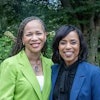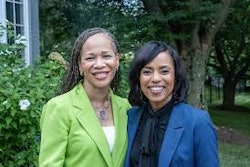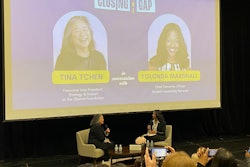 This year’s American Association of State Colleges and Universities (AASCU) MLI Institute protégés stand in front of the U.S. Capitol. (Photo by Peter Cutts/AASCU)
This year’s American Association of State Colleges and Universities (AASCU) MLI Institute protégés stand in front of the U.S. Capitol. (Photo by Peter Cutts/AASCU)When Coppin State University welcomed its new president on July 1, it was a momentous occasion for the university. For the first time in its 115-year history, the institution has a female president, Dr. Evelyn Maria Thompson.
Thompson came to her presidential leadership role by way of the State University of New York at Oneonta and Tennessee State University. She also participated in a few presidential leadership programs, including one at the Harvard Graduate School of Education and one with the American Association of State Colleges and Universities (AASCU). She says both were immensely valuable, but what sets the AASCU program apart from other similar programs is its intriguing social mission.
A number of institutions and organizations, such as Harvard, AASCU and the American Council on Education (ACE), hold annual leadership programs for prospective college or university presidents. They run for a few days a year and prep individuals who are typically in advanced leadership positions on college campuses for the presidential job-search process, as well as what to expect when they take on the job.
AASCU’s Millennium Leadership Initiative (MLI) follows similar lines, holding its institute for several days in Washington, D.C., every June. MLI distinguishes itself from other similar programs in that it was founded with the specific goal of placing more minority and female candidates on track to become university or college presidents.
“Being a woman and being a woman of color, I was very pleased to find a program like MLI,” says Thompson. “I think it’s important to have women in leadership on college campuses. Because of the demographics on most college campuses, you have a higher number of female students to male students.”
Demographic shift
Although diversity is a commonly touted value on almost every college campus and has been for several decades now, the average college or university president is White, male and in his 60s, according to ACE’s comprehensive American College President Survey, which analyzed the demographic profiles of college presidents from 1986 to 2012.
The 2012 portrait of the typical college president has not changed much since 1986. Back then, the typical college president was White, male, Protestant, married with children and held a doctorate in education. One important distinction between 1986 and 2012, however, is that college presidents are about a decade older on average than they were in 1986, indicating that a generation of college presidents is poised to retire. Now, the salient questions are who will replace them and what will the characteristics of the typical college president be?
“In the next five or seven years, we’re going to be losing half or more of the sitting presidents, because baby boomers are retiring. It doesn’t matter whether it’s at independent schools, or the schools that are AASCU-member schools, those numbers still hold pretty much the same,” says Dr. Mary Evans Sias, the recently appointed MLI director and retired president of Kentucky State University. “We really don’t have enough people in the pipeline. So it’s really important that we get good people who are trained so that they can get the jobs and then remain in those jobs.”
Sias joined MLI on June 1, taking over from Dr. Gladys Johnston, who led MLI since its first graduating class in 1999. On the subject of whether there are enough minority presidents, Sias is frank. “We don’t have enough,” she says.
ACE’s 2012 study bodes well for women, but less so for minorities. In 2006, 23 percent of presidents were women, and in 2012, their ranks had grown to 26 percent. High-profile institutions such as Harvard, Brown, the University of Arizona, the University of Wisconsin–Madison and the University of North Carolina at Chapel Hill have female leaders. Approximately 30 percent of community colleges are led by women, too, according to research from Donne G. Kampel, associate dean of faculty at Touro College in New York City.
For minorities, however, the ACE numbers have stayed more or less the same. When excluding minority-serving institutions, the percentage of minority presidents stayed at 9 percent from 2006 to 2012. Between 2006 and 2012, the number of minority presidents overall declined slightly, from 14 to 13 percent.
The question of who should lead institutions is important for the sake of increasing diversity and representation, but another important consideration is the demographic makeup of the students that presidents serve. Some argue that presidents ought to be more representative of their students. More women are enrolling in college than men, for example, particularly among Blacks and Hispanics. The demographics of college campuses are also expected to increasingly become “majority minority.” In 2014, the nation’s public K-12 schools hit the tipping point and are now majority minority.
Since MLI’s inauguration in 1998, 484 “protégés” have graduated from the program. As of press time, 105 have become presidents, some of multiple institutions, according to MLI. AASCU President Muriel A. Howard says she expects that number to grow, although it can be hard to predict at what rate.
As she notes, the presidential pipeline is not always fast-tracked. The process can take years. “We’ll get calls [from former protégés] saying, ‘It took me nine years, but I made it,’” she says.
Presidential glimpse
One of the primary objectives of the institute is to give protégés a glimpse of what it means to be a president. Another key element of the MLI is that the sitting presidents serve as “faculty” when the institute meets, giving aspiring presidents the chance to learn directly from them.
“We think [MLI is] very impactful. Those who have participated in it, and have also been through other leadership programs, tell us that the MLI Institute is the best of all,” says Dr. Mickey L. Burnim, president of Bowie State University and chair of the MLI Executive Steering Committee.
Presidents have an increasingly diffuse list of job requirements, such as serving as the campus lightning rod for the media during the inevitable institutional crisis; spearheading major fundraising efforts; and maintaining sometimes complex relationships with governing boards, trustees and the federal government. While juggling all these demands, presidents are also expected to maintain at least a modicum of grace and panache, no matter how trying the circumstances.
Throughout the conference, protégés meet with sitting presidents to discuss their career path and are occasionally challenged to try out the same tasks presidents are expected to fulfill. For example, protégés spend an afternoon answering questions about campus difficulties from a “reporter” on camera. The institute culminates with a visit to elected officials on Capitol Hill.
MLI’s approach is a hands-on one, but the idea is to give protégés a realistic sense of what lies in store if they decide to become a president. As Sias says, being a college or university president is a round-the-clock job. “One of the strengths of AASCU is that you really want to train people to be presidents, but you also want to give them a real taste of what it’s like on a 24/7 basis to be a university president,” she says. “Because it may not be for everybody and you don’t want somebody getting in the job and finding that out.”
After the institute, graduates are paired with mentors, whom they are expected to remain in contact with and visit their campus to shadow them on the job. Dr. Juliette Bell, who is currently president of the University of Maryland Eastern Shore (UMES), says that Sias was her mentor after she finished the program. Bell serves on the faculty now at the institute, as well as the executive advisory board and the protégé selection committee.
“There is a saying, ‘You don’t know what it’s like to be the president until you’re the president,’ and I think that’s accurate,” Bell says. “But [MLI] certainly gives you insight into what the role entails.”
Staff writer Catherine Morris can be reached at [email protected].















